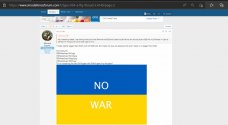THE RABBIT HOLES OF THE IN UKRAINE
Damn. I’m going to have to write all this up! After all the ridicule about Russia’s claims of US/Ukraine using migratory birds for possible delivery of biological pathogens, turns out that was a major research program between Smithsonian Institution and the United States Department of Defense.
More. Turns out that the migratory behaviors of birds can be altered by string selective pressures, and open source shows some experiments along this line. See
The Genetics and Evolution of Avian Migration
Such migratory behaviors can be altered with a few generations. A layman might say the birds have been “taught” altered migratory patterns, but really we’re talking about using natural variations in behavior and selecting for them. Anyway, watch for my upcoming article!
NOTE: I first learned about the poster, Jeffrey Kaye @jeff_kaye from his thorough article on the long-suppressed official report on US biowarfare during the Korean War.
Jeffrey Kaye is a retired psychologist who has worked professionally with torture victims and asylum applicants. Active in the anti-torture movement since 2006, he has his own blog, Invictus, previously wrote regularly for Firedoglake’s The Dissenter, as well as at The Guardian, Truthout, Alternet, and The Public Record. He is the author of Cover-Up at Guantanamo, a new book examining declassified files on treatment of prisoners at the Guantanamo detention camp.
Some excerpts from the interesting article posted at the Washington Post nearly 37 years ago about Pentagon's research on birds in cooperation with the well-known Smithsonian Institution.
SCIENCE
By TED GUP | The Washington Post - May 12, 1985
Twenty years ago, a team of Smithsonian researchers landed on a string of remote Pacific islands to study the comings and goings of sea birds -- terns, albatrosses, gulls. But there was another reason they were there, one stamped "Secret." The leaders of this scholarly band of curators and ecologists reported their findings to military scientists whose interest was not birds but biological weapons.
The Pacific project was two separate missions existing side by side: the Smithsonian's and the Pentagon's. The Smithsonian was only too eager to be given funds to study bird migratory patterns and the military was eager to find "safe" sites for atmospheric testing of biological weapons in the Pacific. Such sites could be determined from the Smithsonian research.
An Army spokesman says military scientists wanted to be certain germs would not be spread beyond the test sites by migrating birds. Other military scientists also wanted to know if sea birds could be used as carriers of biological weapons, winging deadly disease across borders. In military terms, birds could be "avian vectors of disease."
The secret contract was an odd departure for the Smithsonian Institution, beloved and benign. Although the Smithsonian has for decades had unclassified research contracts with the Department of Defense, as it has with other federal departments and agencies, the Pacific Ocean Bird Project was not just another contract.
Smithsonian researchers burned copies of some project notes and correspondence with the military, but many of their originals are preserved in acid-free boxes deep within the Smithsonian's own archives, which are open to the public. Forgotten by many, consulted by few, the 17 square feet of records contain day-by-day accounts, maps, photos and correspondence with the military. All are pieces of a puzzle that show the Pacific Ocean Bird Project was one of the largest and most mysterious undertakings in the institution's 139-year history.
The Smithsonian said at the time that no part of the project was classified "secret." It was. The Smithsonian questioned how its scientists could know the military would use its study for biological weapons research. Some of those in charge of the project did know. In the end, the bird study caused a major self- examination within the Smithsonian that brought about a rededication to never again take on a secret study. And today, 15 years after the project ended, a timeless question remains: What responsibility do scientists and institutions have to weigh how research -- even basic research -- will be used?
THE PACIFIC project spanned eight years, cost the Pentagon $3 million, and involved dozens of Smithsonian staffers and Defense Department workers. From the first, the Smithsonian knew the contract was with the controversial Fort Detrick biological warfare research center in Frederick, Maryland. And even that fact was classified secret. The Smithsonian was prohibited from divulging anything about its work without clearance from Fort Detrick.
Early letters to Smithsonian contract officers made it clear the Army's interest went beyond ornithology. On Oct. 1, 1963, the Army Biological Laboratories at Fort Detrick wrote to Smithsonian administrators about "Material containing Biological Weapons System information which reveals the nondescriptive code designations for BW (Biologic Weapons) agents . . . "
Although the pairing of the Smithsonian and Fort Detrick seems unlikely, in the early 1960s there were numerous ties between the military and research institutions. The Smithsonian's contract was signed in October, 1962, the same month that President Kennedy announced that Soviet missiles were in Cuba. Military exotica flourished: mind control through drugs, porpoises as animate torpedoes, new concoctions of chemical and biological weapons, turning life against life. It was a macabre time of Strangelovean fantasies when even one of God's gentlest creatures, a gull, could be considered for a doomsday assignment.
And there was another, simpler reason the Smithsonian took the contract. Money. The Smithsonian wanted more research funds.
( . . . )
Damn. I’m going to have to write all this up! After all the ridicule about Russia’s claims of US/Ukraine using migratory birds for possible delivery of biological pathogens, turns out that was a major research program between Smithsonian Institution and the United States Department of Defense.
More. Turns out that the migratory behaviors of birds can be altered by string selective pressures, and open source shows some experiments along this line. See
The Genetics and Evolution of Avian Migration
Such migratory behaviors can be altered with a few generations. A layman might say the birds have been “taught” altered migratory patterns, but really we’re talking about using natural variations in behavior and selecting for them. Anyway, watch for my upcoming article!
NOTE: I first learned about the poster, Jeffrey Kaye @jeff_kaye from his thorough article on the long-suppressed official report on US biowarfare during the Korean War.
Jeffrey Kaye is a retired psychologist who has worked professionally with torture victims and asylum applicants. Active in the anti-torture movement since 2006, he has his own blog, Invictus, previously wrote regularly for Firedoglake’s The Dissenter, as well as at The Guardian, Truthout, Alternet, and The Public Record. He is the author of Cover-Up at Guantanamo, a new book examining declassified files on treatment of prisoners at the Guantanamo detention camp.
Some excerpts from the interesting article posted at the Washington Post nearly 37 years ago about Pentagon's research on birds in cooperation with the well-known Smithsonian Institution.
SCIENCE
By TED GUP | The Washington Post - May 12, 1985
Twenty years ago, a team of Smithsonian researchers landed on a string of remote Pacific islands to study the comings and goings of sea birds -- terns, albatrosses, gulls. But there was another reason they were there, one stamped "Secret." The leaders of this scholarly band of curators and ecologists reported their findings to military scientists whose interest was not birds but biological weapons.
The Pacific project was two separate missions existing side by side: the Smithsonian's and the Pentagon's. The Smithsonian was only too eager to be given funds to study bird migratory patterns and the military was eager to find "safe" sites for atmospheric testing of biological weapons in the Pacific. Such sites could be determined from the Smithsonian research.
An Army spokesman says military scientists wanted to be certain germs would not be spread beyond the test sites by migrating birds. Other military scientists also wanted to know if sea birds could be used as carriers of biological weapons, winging deadly disease across borders. In military terms, birds could be "avian vectors of disease."
The secret contract was an odd departure for the Smithsonian Institution, beloved and benign. Although the Smithsonian has for decades had unclassified research contracts with the Department of Defense, as it has with other federal departments and agencies, the Pacific Ocean Bird Project was not just another contract.
Smithsonian researchers burned copies of some project notes and correspondence with the military, but many of their originals are preserved in acid-free boxes deep within the Smithsonian's own archives, which are open to the public. Forgotten by many, consulted by few, the 17 square feet of records contain day-by-day accounts, maps, photos and correspondence with the military. All are pieces of a puzzle that show the Pacific Ocean Bird Project was one of the largest and most mysterious undertakings in the institution's 139-year history.
The Smithsonian said at the time that no part of the project was classified "secret." It was. The Smithsonian questioned how its scientists could know the military would use its study for biological weapons research. Some of those in charge of the project did know. In the end, the bird study caused a major self- examination within the Smithsonian that brought about a rededication to never again take on a secret study. And today, 15 years after the project ended, a timeless question remains: What responsibility do scientists and institutions have to weigh how research -- even basic research -- will be used?
THE PACIFIC project spanned eight years, cost the Pentagon $3 million, and involved dozens of Smithsonian staffers and Defense Department workers. From the first, the Smithsonian knew the contract was with the controversial Fort Detrick biological warfare research center in Frederick, Maryland. And even that fact was classified secret. The Smithsonian was prohibited from divulging anything about its work without clearance from Fort Detrick.
Early letters to Smithsonian contract officers made it clear the Army's interest went beyond ornithology. On Oct. 1, 1963, the Army Biological Laboratories at Fort Detrick wrote to Smithsonian administrators about "Material containing Biological Weapons System information which reveals the nondescriptive code designations for BW (Biologic Weapons) agents . . . "
Although the pairing of the Smithsonian and Fort Detrick seems unlikely, in the early 1960s there were numerous ties between the military and research institutions. The Smithsonian's contract was signed in October, 1962, the same month that President Kennedy announced that Soviet missiles were in Cuba. Military exotica flourished: mind control through drugs, porpoises as animate torpedoes, new concoctions of chemical and biological weapons, turning life against life. It was a macabre time of Strangelovean fantasies when even one of God's gentlest creatures, a gull, could be considered for a doomsday assignment.
And there was another, simpler reason the Smithsonian took the contract. Money. The Smithsonian wanted more research funds.
( . . . )



